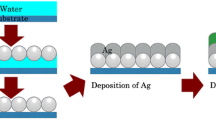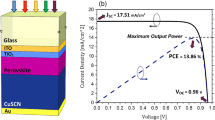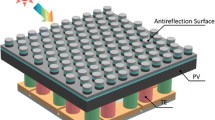Abstract
In this study, optimization of the silicon nanopillar arrays and thin films coated on silicon substrate has been investigated in order to minimize the optical reflection loss from the silicon substrate surface. Nanopillars’s filling ratio, pillar height, pillars diameter, sidewall incline angle, and step coverage with dielectric thin film thickness are systematically optimized together for the first time with these type of nanostructures. Full-field Finite Difference Time Domain method is used to simulate electro-magnetic fields and calculate the reflection from the modified nanostructured substrate surfaces in 400-1100 nm spectral range. Optimization recipe is clearly presented and this is not only useful for hexagonal arrays but also for regular arrays of nanopillars in general. We also further decrease the reflection by using step coverage concept which is the result of nonconformal coating on steps and trenches of thin films. We obtained approximately 2% of weighted average reflection in the 400-1100 nm range for perpendicular incident solar radiation which is one of the best results reported for this type of nanostructured surfaces in the literature.
Similar content being viewed by others
Data Availability
The datasets used in the plots and they were already presented in the manuscript. However, the raw data used to generate the figures in the manuscript are available from the corresponding author on reasonable request.
References
Campbell P, Green MA (1987) Light trapping properties of pyramidally textured surfaces. J Appl Phys 62(1):243–249
Boden SA, Bagnall DM (2008) Tunable reflection minima of nanostructured antireflective surfaces. Appl Phys Lett 93(133108). https://doi.org/10.1063/1.2993231
Boden SA, Bagnall DM (2010) Optimization of moth-eye antireflection schemes for silicon solar cells. Prog Photovolt 18(3):195–203
Chattopadhyay S, Huang YF, Jen YJ, Ganguly A, Chen KH, Chen LC (2010) Anti-reflecting and photonic nanostructures. Mater Sci Eng R-Rep 69(1–3):1–35
Hadobas K, Kirsch S, Carl A, Acet M, Wassermann EF (2000) Reflection properties of nanostructure-arrayed silicon surfaces. Nanotechnology 11(3):161–164
Huang YF, Chattopadhyay S, Jen YJ, Peng CY, Liu TA, Hsu YK, Pan CL, Lo HC, Hsu CH, Chang YH, Lee CS, Chen KH, Chen LC (2007) Improved broadband and quasi-omnidirectional anti-reflection properties with biomimetic silicon nanostructures. Nat Nanotechnol 2(12):770–774
Kanamori Y, Sasaki M, Hane K (1999) Broadband antireflection gratings fabricated upon silicon substrates. Opt Lett 24(20):1422–1424
Lalanne P, Morris GM (1997) Antireflection behavior of silicon subwavelength periodic structures for visible light. Nanotechnology 8(2):53–56
Pai YH, Lin YC, Tsai JL, Lin GR (2011) Nonlinear dependence between the surface reflectance and the duty-cycle of semiconductor nanorod array. Opt Express 19(3):1680–1690
Sai H, Fujii H, Arafune K, Ohshita Y, Kanamori Y, Yugami H, Yamaguchi M (2007) Wide-angle antireflection effect of subwavelength structures for solar cells. Jpn J Appl Phys Part 1-Regular Papers Brief Commun Rev Papers 46(6A):3333–3336
Sai H, Fujii H, Arafune K, Ohshita Y, Yamaguchi M, Kanamori Y, Yugami H (2006) Antireflective subwavelength structures on crystalline Si fabricated using directly formed anodic porous alumina masks. Appl Phys Lett 88(201116). https://doi.org/10.1063/1.2205173
Sai H, Kanamori Y, Arafune K, Ohshita Y, Yamaguchi M (2007) Light trapping effect of submicron surface textures in crystalline Si solar cells. Prog Photovolt 15(5):415–423
Shin JC, Chanda D, Chern W, Yu KJ, Rogers JA, Li XL (2012) Experimental study of design parameters in silicon micropillar array solar cells produced by soft lithography and metal-assisted chemical etching. IEEE J Photovolt 2(2):129–133
Seliger P, Mahvash M, Wang CM, Levi AFJ (2006) Optimization of aperiodic dielectric structures. J Appl Phys 100(3)
Callahan DM, Munday JN, Atwater HA (2012) Solar cell light trapping beyond the ray optic limit. Nano Lett 12(1):214–218
Spinelli P, Verschuuren MA, Polman A (2012) Broadband omnidirectional antireflection coating based on subwavelength surface Mie resonators. Nat Commun 3(692). https://doi.org/10.1038/ncomms1691
Wang KXZ, Yu ZF, Liu V, Cui Y, Fan SH (2012) Absorption enhancement in ultrathin crystalline silicon solar cells with antireflection and light-trapping Nanocone gratings. Nano Lett 12(3):1616–1619
Boroumand J, Das S, Vazquez-Guardado A, Franklin D, Chanda D (2016) Unified electromagnetic-electronic design of light trapping silicon solar cells. Sci Rep 6(31013). https://doi.org/10.1038/srep31013
Shir D, Yoon J, Chanda D, Ryu JH, Rogers JA (2010) Performance of ultrathin silicon solar microcells with nanostructures of relief formed by soft imprint lithography for broad band absorption enhancement. Nano Lett 10(8):3041–3046
Yu KJ, Gao L, Park JS, Lee YR, Corcoran CJ, Nuzzo RG, Chanda D, Rogers JA (2013) Light trapping in ultrathin monocrystalline silicon solar cells. Adv Energy Mater 3(11):1401–1406
Chong TK, Wilson J, Mokkapati S, Catchpole KR (2012) Optimal wavelength scale diffraction gratings for light trapping in solar cells. J Opt 14(024012). https://doi.org/10.1088/2040-8978/14/2/024012
Branham MS, Hsu WC, Yerci S, Loomis J, Boriskina SV, Hoard BR, Han SE, Chen G (2015) 15.7% efficient 10-mu thick crystalline silicon solar cells using periodic nanostructures. Adv Mater 27(13):2182
Garnett E, Yang PD (2010) Light trapping in silicon nanowire solar cells. Nano Lett 10(3):1082–1087
Karakasoglu I, Wang KXZ, Fan SH (2015) Optical-electronic analysis of the intrinsic behaviors of nanostructured ultrathin crystalline silicon solar cells. ACS Photonics 2(7):883–889
Lee SM, Biswas R, Li WG, Kang D, Chan L, Yoon J (2014) Printable nanostructured silicon solar cells for high-performance, large-area flexible photovoltaics. ACS Nano 8(10):10507–10516
Mavrokefalos A, Han SE, Yerci S, Branham MS, Chen G (2012) Efficient light trapping in inverted nanopyramid thin crystalline silicon membranes for solar cell applications. Nano Lett 12(6):2792–2796
Weinstein LA, Hsu WC, Yerci S, Boriskina SV, Chen G (2015) Enhanced absorption of thin-film photovoltaic cells using an optical cavity. J Opt 17(055901). https://doi.org/10.1088/2040-8978/17/5/055901
Zhou DY, Biswas R (2008) Photonic crystal enhanced light-trapping in thin film solar cells. J Appl Phys 103(093102). https://doi.org/10.1063/1.2908212
Spinelli P, Polman A (2014) Light trapping in thin crystalline Si solar cells using surface Mie Scatterers. IEEE J Photovolt 4(2):554–559
Mutitu JG, Shi SY, Chen CH, Creazzo T, Barnett A, Honsberg C, Prather DW (2008) Thin film silicon solar cell design based on photonic crystal and diffractive grating structures. Opt Express 16(19):15238–15248
Bielawny A, Upping J, Miclea PT, Wehrspohn RB, Rockstuhl C, Lederer F, Peters M, Steidl L, Zentel R, Lee SM, Knez M, Lambertz A, Carius R (2008) 3D photonic crystal intermediate reflector for micromorph thin-film tandem solar cell. Phys Status Solidi A-Appl Mater Sci 205(12):2796–2810
Palik E (1985) Handbook of optical constants of solids, 1st ed. Academic, Cambridge
Park H, Dan Y, Seo K, Yu YJ, Duane PK, Wober M, Crozier KB (2014) Filter-free image sensor pixels comprising silicon nanowires with selective color absorption. Nano Lett 14(4):1804–1809
Tut T, Dan YP, Duane P, Yu Y, Wober M, Crozier KB (2012) Vertical waveguides integrated with silicon photodetectors: Towards high efficiency and low cross-talk image sensors. Appl Phys Lett 100(043504). https://doi.org/10.1063/1.3678019
Sopori BL, Pryor RA (1982) Design of antireflection coatings for textured silicon solar cells. Solar Cells 8:249–261
Guardado AV, Boroumand J, Franklin D, Chanda D (2018) Broadband angle-independent antireflection coatings on nanostructured light trapping solar cells. Phys Rev Mater 2:035201
Yan W, Dottermusch S, Reitz C, Richards BS (2016) Hexagonal arrays of round-head silicon nanopillars for surface anti-reflection applications. Appl Phys Lett 109:143901
Li J, Yu H, Wong SM, Zhang G, Sun X, Lo PG, Kwong D (2009) Nanopyramid structure for ultrathin c-Si tandem solar cells. Appl Phys Lett 95:033102
Lin C, Huang N, Povinelli ML (2011) Effect of aperiodicity on the broadband reflection of silicon nanorod structures for photovoltaics. Opt Express 20(1):125–132
Proust J, Fehrembach A, Bedu F, Ozerov I, Bonod N (2016) Optimized 2D array of thin silicon pillars for efficient antireflective coatings in the visible spectrum. Sci Rep 6:24947
Kim J, You S (2021) Surface texturing of Si with periodically arrayed oblique nanopillars to achieve antireflection. Materials 14:380
Acknowledgements
This work is funded by TUBİTAK ARDEB 1001 project under project number 219M280. Computing resources were supported by AGÜ (Abdullah Gul University). I would like to thank my colleagues Evren Mutlugün and Mehmet Şahin for valuable discussions on the subject.
Funding
This work was supported by Tubitak 1001 program under the grant number 219M280.
Author information
Authors and Affiliations
Contributions
Material preparation, data collection and analysis and manuscript writing were performed by Turgut TUT.
Corresponding author
Ethics declarations
Competing Interests
The author has no relevant financial or non-financial interests to disclose.
Ethics Approval
Not applicable for this paper.
Consent to Participate
Not applicable.
Consent to Publish
Not applicable.
Additional information
Publisher’s Note
Springer Nature remains neutral with regard to jurisdictional claims in published maps and institutional affiliations.
Rights and permissions
About this article
Cite this article
Tut, T. Broadband Low Reflection Surfaces with Silicon Nanopillar Hexagonal Arrays for Energy Harvesting in Photovoltaics. Silicon 14, 12781–12788 (2022). https://doi.org/10.1007/s12633-022-01977-0
Received:
Accepted:
Published:
Issue Date:
DOI: https://doi.org/10.1007/s12633-022-01977-0




